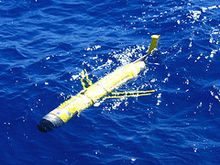
Back Unterwassergleiter German Planeador submarino Spanish Planeur sous-marin French Glider (AUV) Italian Podwodny szybowiec Polish Planador subaquático Portuguese Подводный планёр Russian Підводний планер Ukrainian 水下滑翔機 Chinese

An underwater glider is a type of autonomous underwater vehicle (AUV) that employs variable-buoyancy propulsion instead of traditional propellers or thrusters. It employs variable buoyancy in a similar way to a profiling float, but unlike a float, which can move only up and down, an underwater glider is fitted with hydrofoils (underwater wings) that allow it to glide forward while descending through the water. At a certain depth, the glider switches to positive buoyancy to climb back up and forward, and the cycle is then repeated.
While not as fast as conventional AUVs, gliders offer significantly greater range and endurance compared to traditional AUVs, extending ocean sampling missions from hours to weeks or months, and to thousands of kilometers of range.[1] The typical up-and-down, sawtooth-like profile followed by a glider can provide data on temporal and spatial scales unattainable by powered AUVs and much more costly to sample using traditional shipboard techniques. A wide variety of glider designs are in use by navies and ocean research organizations, with gliders typically costing around US$100,000.[2]
- ^ "Seaglider: Autonomous Underwater Vehicle". Applied Physics Laboratory, University of Washington. Retrieved 2020-04-24.
- ^ US patent 7987674, Jack A. Jones; Yi Chao & Thomas I. Valdez, "Phase Change Material Thermal Power Generator", issued 2011-08-02